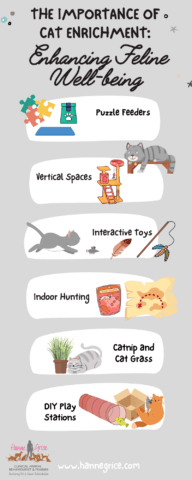Cats are intriguing creatures known for their independence, agility, and curiosity. So an important factor in cat ownership is to nurture their innate behaviours, providing for their physiological and psychological needs – this is where cat enrichment comes in!
Cat enrichment is crucial in maintaining their well-being, mental stimulation, and physical health. In this post, I explore why cat enrichment matters and provide practical examples of how you can enhance your cat’s environment.
Why is Cat Enrichment Important?
Cats are natural hunters and explorers, and their instinctual needs should be met even in a domestic setting. By providing a stimulating and enriching environment, we can help reduce the likelihood of behavioural issues, reduce stress, and promote a more balanced and fulfilled life for our feline friends. Here are some reasons why cat enrichment is important:
- Mental Stimulation: Cats need mental challenges to keep their brains active. Enrichment activities engage their problem-solving skills preventing boredom and associated destructive behaviours such as scratching and chewing.
- Physical Exercise: Interactive and engaging enrichment activities promote physical exercise, which is vital for maintaining a healthy weight and preventing obesity-related health issues.
- Stress Reduction: Appropiate cat enrichment helps alleviate stress and anxiety in cats by providing outlets for their natural behaviours and instincts. Enrichment boosts the production of ‘happy’ hormones, and offers a sense of security, comfort, and a more fulfilling daily routine.
- Bonding and Socialisation: Enrichment activities that involve interaction with owners encourage bonding and strengthen the human-animal relationship.
Examples of Cat Enrichment Activities
- Puzzle Feeders: Utilise puzzle feeders, cat lickee mats, or treat-dispensing toys that encourage your cat to work for their food. These toys simulate hunting behaviours and provide mental stimulation. Examples include food-dispensing balls, treat puzzles, and slow feeder bowls.
- Vertical Spaces: Cats love to climb and observe their surroundings from elevated positions – this helps them feel safer, reduces stress and is critical where we have a multi-pet household. Install cat trees, shelves, or window perches to create vertical spaces for your cat to explore and rest.
- Interactive Toys: Engage your cat with interactive toys, such as feather wands, open lidded cardboard boxes with cat treats/feathers/leaves from the garden hidden inside, or puzzle toys that encourage chasing and pouncing. Rotate the toys regularly to keep them fresh and exciting. Avoid using laser pens as these can drive frustration where your cat can never ‘win’ their prey and this is likely to have negative behavioural consequences. And, avoid toys with hard, sharp edges or bits that could come off and be swallowed.
- Indoor Hunting: Mimic the hunting experience by hiding treats or kibble around the house or in, around and under cat activity mats for your cat to find. This taps into their natural instincts and keeps them mentally and physically active. It is important to avoid those natural hunting instincts being directed onto owners where they may use ‘hand play’. This is where owners use their hands or fingers to elicit chasing/pouncing on them and this can, unwittingly, encourage scratching, grabbing and biting onto owners when they least expect it or when their cat is frustrated.
- Catnip and Cat Grass: Many cats enjoy the effects of catnip, which can be used in toys or as a training aid. Additionally, growing cat grass indoors provides a safe and natural way for cats to satisfy their chewing and grazing instincts. Chewing can also be encouraged onto appropiate cat items such as Matabati sticks (silver vine) but always supervise your cat when they are using these chewables.
- DIY Play Stations: Get creative and build your own play stations using cardboard boxes, tunnels, hiding spots, even a pet teepee. These inexpensive DIY options can offer endless hours of fun for your cat.
Cat enrichment is an integral part of responsible pet ownership. By providing a stimulating environment that addresses your cat’s natural instincts, you can enhance their well-being, mental health, and overall happiness.
Remember to incorporate a variety of enrichment activities into your cat’s routine, and observe their preferences to tailor the experience to their individual needs. A contented and engaged cat will lead a more fulfilled life, and you’ll enjoy a stronger bond with your feline companion.
References:
- Landsberg, G. (2018). Improving the Welfare of Cats through Environmental Enrichment. Journal of Feline Medicine and Surgery, 20(11), 1049-1061.
- Ellis, S. L., & Wells, D. L. (2010). The influence of olfactory stimulation on the behaviour of cats housed in a rescue shelter, Applied Animal Behaviour Science, Volume 123, Issues 1–2, 2010, Pages 56-62, ISSN 0168-1591, https://doi.org/10.1016/j.applanim.2009.12.011
Learn more about our classes

Get Hanne's book, clothing and more
Hanne has a number of publications including her book Playing With Your Dog to help owners work out the games that are best suited for their pet to play throughout his life, from puppyhood to old age, available from Amazon. Check out Hanne's range of contemporary casuals The Collection – for pet lovers made from recyclable, organic materials that are sustainably sourced.


